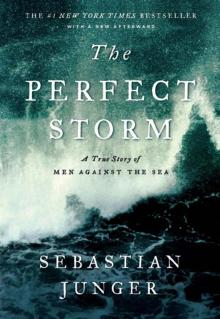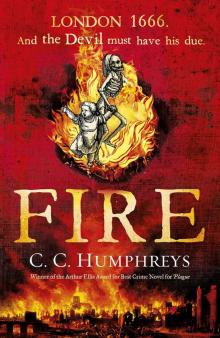- Home
- Sebastian Junger
Fire Page 4
Fire Read online
Page 4
“So, you guys know anything about that rattler back there?” Casey asked.
There was silence. Every man in the crew looked off in a different direction.
“Rattler?” Glen Stillsmoking, the crew boss, finally said.
“Sons of bitches,” Casey muttered, shaking his head but with a smile.
We sat down in the shade to drink some water and take in the view. One of the crew pulled an obsidian arrowhead from his pocket; he said he’d found it at the helispot at Barber Flats. Stillsmoking leaned in to take a look. “We were a pretty hostile people,” he admitted, looking around at his crew. “We ran Chief Joseph off; we were the last to settle down. But now we make good fire fighters. My father was a fire boss; I wanted to go to flight school, but fire just drew me away. We’ve been to Alaska, Florida, paid vacations—that’s what we call work—everywhere. At the safety briefings in Florida they told us to watch out for the alligators.”
Downslope, a pair of sawyers—sawdogs, they’re called—were dropping snags; the sound of their Stihls reached us as a puny whine. A lone ponderosa burned lazily behind us a mile away, and the river glinted far below us in the canyon. This was probably as peaceful as it got on a fire line, and the crew didn’t seem in a particular hurry to ruin the moment. I leaned back and tried to stop wishing the fire would do something big.
The season blew up a few weeks later. I was back on the East Coast when I got a call from Frank Carroll, the information officer for the Boise National Forest, who said that lightning strikes were now starting fires by the dozen at the upper elevations. A twenty-year-old fire fighter had been killed by a snag at the tiny Cascade fire; it hit her so hard that her hard hat was driven into her head. A smoke jumper broke his pelvis while landing on the Red Mountain fire. The town of Cuprum had to be cleared of all thirty residents when the Windy Ridge fire detonated into a five-thousand-acre blaze in one afternoon. A Diamond Mountain hotshot on the Horsefly fire was knocked five hundred feet down a hillside by a flaming log because he had shoved a friend out of the way before trying to dodge it himself. A total of eleven thousand people were on the fire lines at one time, Carroll said, and water levels were so low that Boise-area farmers had been shut off two months early.
A big runaway fire was almost inevitable, and it finally hit at the end of August. On the afternoon of Wednesday, August 19, a thunderstorm swept past Boise and lightning ignited the rangeland east of town. The fire quickly overwhelmed the BLM engine crews sent to deal with it and made its way up into the Boise foothills, leaping the quarter-mile-wide canyon of the South Fork of the Boise River with ease. By then it was in steep terrain and flashing through the grass and sagebrush almost faster than a person could run. Temperatures were in the nineties, and the relative humidity had bottomed out at 5 percent. Conditions were so fast that the fire encircled the town of Prairie and almost torched it, forcing the evacuation of all one hundred residents. The only store in town—complete with a hitching post and a bar—was selling T-shirts that said: “We interrupt this marriage to bring you the fire season.”
It was called the Foothills fire, and I got on it ten days after it first ignited. Snags in the timber were dropping at an estimated rate of forty an hour, prompting overhead to pull crews off the lines at night. This in turn prompted locals to say that the fire fighters weren’t working hard enough. I was assigned to the Union Hotshots out of La Grande, Oregon. Not only was Union one-third women, but its crew boss, Kelly Esterbrook, was one of only ten women ever to have made it through the brutal smoke jumper training course. The Union Hotshots were one of three crews guarding a strategic section of the fire line and if temperatures stayed high and the wind picked up, they would be right in the middle of things. The fire could roll right across the handlines and into a big stand of diseased ponderosa in the high country, and if it did that, it would be virtually unstoppable.
A public information officer named Karen Miranda had been assigned to take me up the fire line to meet the Union Hotshots. I picked up my Nomex clothes and fire shelter at the Forest Service headquarters in Boise, bought notebooks and blank cassette tapes, and raced east toward the town of Prairie. It was thirty miles away across a huge swath of dead black rangeland. I had to make the fire camp before three o’clock, when the helicopters started making their evening runs out to the crews, and I got in with a half hour to spare. When I walked up to Ed Nesselroad, the senior fire information officer, he was telling someone about a live elk that had been found with its eyes burned out. He quickly rounded up Karen Miranda, and by late afternoon we were strapped into the canvas seats of an Evergreen helicopter and waiting to be shipped to helispot six—H-6, as it is called—northeast of Prairie.
We got the same warnings as before, except that this time we were shown the emergency shutoffs in case we crashed and the pilot was unconscious. (Never get out of a downed helicopter with the rotors still turning.) We lifted off and immediately could see a cauldron of smoke boiling up out of a valley. Dozens of helicopters flew in and out dumping retardant, and away to the south stretched an endless carpet of blackened rangeland. Trees torched below us, and the sweet, sharp smell of smoke filled the cabin. The helicopter made several low passes at H-6 and finally settled down after the helispot crew had cleared some cargo out of the way.
H-6 was on a ridge just below a vegetation line where ponderosa gave way to alpine fir. Just over a hill was tiny Smith Creek Lake, cupped in the topography like a jewel in some huge brown palm. Tents and bedrolls were scattered through the ponderosa. Hotshots lounged with books or talked in small groups or just sat and stared. A slingload of gear waited to be sorted below the helispot, and near it was a huge pile of cardboard boxes and plastic buckets. It was our food for two days.
An inflamed red sun was setting over the ridge, and smoke was pumping out of a valley to the west of us. Occasionally a tree torched on the ridge and then died down, lighting the campsite—it was dark by the time we ate—with a dull glow. Hotshots stopped eating and turned to watch. These were people who couldn’t even remember how many fires they’d been on, I thought. Still, they couldn’t keep from looking at open flame. There are stories of crews getting overrun by fire because they were too mesmerized by it to run away.
The camp we were at was termed a spike camp, and the hotshots here—sixty of them plus several helitack crew members—were said to be spiked out. That meant that they were established in a roadless area and supplied by helicopter with food, tools, and paper sleeping bags (marginally warm but washable and reusable). According to Forest Service policy, hotshots should not be spiked out for more than two days in a row. One level less comfortable than a spike camp is the coyote camp, and hotshots are not universal in their love of coyote camps. Coyoteing, as it is called, means dropping in exhaustion wherever you happen to be when it gets dark. Because hotshots have only their line packs when they fight fire, they are usually caught without food, sleeping bags, extra clothes. If it’s cold, they will make a fire in the black—the burned area—and huddle around it all night. If it’s really cold, they might decide to keep building line simply to keep warm. For food, they might have thought to pack some military MREs (meals ready to eat). If not, they go hungry.
The trees torched intermittently all night, I would wake up and see their glow. The sound of flames consuming pine trees one by one easily carried the mile to camp. I tried, and failed, to imagine what it would be like to be burned over. In 1910 a fire storm overtook a group of forty-five fire fighters who were trying to escape an Idaho fire called the Big Blowup. The leader, Edward Pulaski—who later manufactured the tool that bears his name—led them into an abandoned mine shaft and had to keep them there at gunpoint because they were so terrified. Five men died; the rest emerged several hours later, burned and dazed. They had survived a fire storm of such ferocity that entire hillsides of timber had been flattened by fire and convection wind.
The hotshots were up well before dawn, as usual, rustling about quietly with their head la
mps on. It was very, very cold at that altitude at that hour, and I put on everything I had and wandered down the hill to the kitchen area. There would be a briefing at six while people ate, and then they would attack the fire. The smell of smoke still permeated the camp, but the fire had quieted down during night, and trees no longer torched along the ridge. Fires generally “lay down” after dark because the temperature drops, meaning that the relative humidity rises. People poured themselves cereal and coffee and sat on the hillside, eating and listening to the morning briefing.
The division supervisor, a gruff, stocky man named Fred Bird, stood on a crate in the half-light and projected the plans for the day out across the mountainside. “Okay, we’re gonna try to hold our own on that ridge,” he said. “We’ve got good air support, and they’re going to work us here all day today and then bump us back to camp. Tomorrow they’ll get in some type two crews to hold the ridge and send ’shot crews up to the North Zone to chase spots down that canyon.”
One hundred and seventeen miles of fire line had been built, there were only ten more miles to build, and overhead was saying that the fire was nearly contained. Everyone knew that one good spot into some timber could start the fire running again, though. Bird’s briefing was short and to the point, and sunlight was just touching the upper ridges when the three crews shouldered their packs and started off up the hillside. I fell in with the Union Hotshots, followed by Karen Miranda, and we worked our way slowly up a steep drainage that ended at a ridge, heavy timber on the far side. Burned timber. In the absence of wind, the ridge had acted as a fire line, and Union was simply going after the spots that had made it over. Spots were anything from a few square feet of ash to a vigorously flaming snag surrounded by an acre of black, but they all had to be put out. We were in sparse alpine fir now, Kelly Esterbrook said, and fire in alpine fir is very hard to fight. The trees blow sparks as they burn, igniting spot fires everywhere, and they grow in dense groves that provide critically high fuel loads when the fire reaches them. The flames climb up into the trees from the lower branches, which often reach to the ground, and make their way up into the densely packed crowns. A crown fire is particularly hard to stop because the fire moves from tree to tree without ever touching the ground. You can stop a crown fire only by cutting a lot of trees down, and after a certain point it becomes a case of cutting down the forest to save it.
The Union crew spread out in pairs to hit the spot fires and Miranda and I climbed on to the crest of the ridge. Below us, an entire river drainage of charred trees stretched away to the west. Occasionally a solitary tree torched down in the valley and sent up a tremendous plume of smoke. A temperature inversion had trapped the smoke low in the valley, and Miranda said that when it lifted—when the smoke started to rise—that meant that the air was turning over, and convection would invigorate the fire. At that point they would probably call in a substantial air attack in an effort to keep the fire contained on the west side of the ridge.
We followed the ridge, which climbed toward a peak that we had seen above camp. Below us on our right, the forest smoked. Below us on our left, hotshots worked the spot fires in small groups of three or four. An enormous Siller Brothers Skycrane helicopter with a bucket clattered up and down the valley, unleashing two thousand gallons of Smith Creek Lake water at a time. Four sawyers from the Smokey Bear crew dropped a flame-gutted ponderosa and then called in a water drop, and the Skycrane responded in minutes. Two thousand gallons, hitting a hillside from a hundred feet, is practically enough water to body surf downhill through the trees. When the water subsided, the sawyers bent over and began grubbing through the wet soil for embers.
Twenty minutes later, as they were finishing up, a message came over their radio from the fire camp: “Steve Shaeffer, Steve Shaeffer, Smokey Bear, your wife is in the hospital at this moment having a baby.” The sawyers grinned at one another; it was rare that overhead called with personal news that wasn’t bad. Shaeffer was farther up the ridge, hitting spots alongside the Negrito crew. He wasn’t able to go home, but at least he’d gotten the news.
At the top of the ridge we were met by the branch director, a strapping dark-haired man with a white-flecked beard and wind-burned face named Mike Rieser. He had fought fires since 1973 and was now fire control officer for the BLM Craig District in Colorado. We sat down and opened our lunches on a rock outcrop that overlooked the burning valley.
Rieser has personally known eight people who died on fires. “Wildland fire fighting has one of the highest incidences of fatalities and injury in the country,” he said. “In 1990 twenty-three people died, out of ten thousand active fire fighters. Six died on the convict crew at the Dude fire in Arizona, and that same week two were burned over in California. I saw a film of the first walk-through after the Dude fire; the heat varied so much that one shelter would be fine and the next one would have started to disintegrate.”
The Dude fire happened along the Mogollon Rim, on the north side of the Grand Canyon. It was a classic plume-dominated fire, but the topography of the rim served to intensify the downdrafts. Moments before the fire blew up, the Prescott Hotshots noticed a strange calm that often precedes a plume-dominated situation and radioed the overhead team that they were pulling out. The Perryville inmate crew and the Navajo Scouts crew were warned of the danger as well, but they were in exactly the wrong spot. The downdraft hit right in front of them and, funneled by the contours of the canyon rim, drove the fire straight toward them. Half the inmate crew escaped, as did the entire Navajo Scouts crew. The rest of the fire fighters dived into their shelters and waited for the flame front to pass over them.
From laboratory tests, researchers know that the adhesive that holds fire shelters together starts to melt at six hundred degrees Fahrenheit. That causes the fiberglass and aluminum layers to delaminate, in turn leading to rips and holes in the shelter. After the Dude fire, investigators found hard hats that had melted, leather gloves that had shrunk down to a couple of inches, and fire shelters that had begun to delaminate. Six men died, all from breathing superheated air. In all six cases they died because they had not deployed their shelters properly or because they had tried to leave them too quickly. Some of the survivors also suffered terrible burns, which suggest another possibility. The men who left the safety of their shelters may have done so because they thought they were dying inside them.
Mike Rieser and I sat on a rock outcrop eating our lunches and watching the fire. The sun was very hot and trees torched occasionally down in the valley. Every five minutes the Skycrane went by with a tremendous whump of rotors and released another two thousand gallons of Spring Creek Lake. Clouds began to move in above us, and Rieser said that they were called lenticular clouds and that the sculpted tops meant that the upper-level winds were over one hundred miles an hour. If those winds made it down to ground level, they would have a catastrophic effect on the fire. It was his job as branch director to watch out for things like lenticularis formations or castellanus or stage three cumulonimbus or anything else that might make the fire blow up. Two days earlier Rieser had pulled two entire divisions out of a canyon because he hadn’t liked the way the fire was behaving.
“We might not look like we’re doing much, but if you’re down in the valley digging, you don’t see what’s coming at you,” he said. “Air can rise off a fire, cool in the upper atmosphere, and rush back down. It superheats as it comes down and can overpower the wind field. That’s called a plume-dominated fire. It defies prediction. It’s what killed the people at the Dude fire; the ’shot crews recognized plume-dominated conditions, but the convict crew didn’t. No one could get word to them in time.”
Stage three cumulonimbus, thunderclouds, are a particular hazard. Not only do they introduce more lightning into the situation, but the air beneath their thirty-thousand-foot heads is extremely unstable. They can generate downward-moving winds of as much as one hundred miles an hour that hit the ground and spread out in a tremendous circle. The effect is to intens
ify the interaction among all three components of what is known as the fire triangle: fuel, oxygen, and heat. Ground winds spread dry, hot air through as yet unburned fuels, resulting in more fire and more heat, which in turn circulate more air, spreading the fire even faster. The result is a feedback loop that can be brought under control only if the relationships within the fire triangle break down—either by lowering the temperature of the fire or by depriving it of fuel. Water and retardant drops can bring the temperature of a fire down, and fire lines can deprive it of fuel. Otherwise, the fire spreads until the weather changes or there’s nothing left to burn.
In the Northern Rockies wildfire is usually started by lightning. Any lightning strike that reaches the ground can cause an explosion, but only lightning with a continuous current can start fires. In the Northern Rockies it has been estimated that one lightning stroke in twenty-five is a cloud-to-ground stroke capable of starting a fire. The inital bolt from cloud to ground moves relatively slowly, at one two-thousandths the speed of light, but it returns at one-tenth the speed of light and heats the gases inside it to fifty thousand degrees Fahrenheit. That much energy hitting a tree instantly raises it way past the ignition point, and often the tree just explodes. Flaming chunks of wood are hurled into the forest, and if the conditions are right for fire, the flames take hold.
Fire is a chemical reaction that releases energy in the form of light and heat. In the case of a wood fire, the energy was originally derived from the sun during photosynthesis and stored in the plant as cellulose and lignin. Heat—from a fire that is already burning or from a lightning strike—converts the cellulose and lignin into flammable gases, which are driven out of the wood and combined with oxygen in a process called rapid oxidation. At the base of any flame there is a clear band of superheated gases that have not yet ignited, a thin blue area of ignited gases, and a broad yellow band of incandescent carbon particles. The heat generated by this process continues to drive flammable gases out of more fuels, which burn and generate more heat. The heat also drives out moisture that might impede combustion. As long as there is sufficient air, fuel, and heat to ignite more fuel, the fire will keep advancing. As long as the fire keeps advancing, the fire triangle remains stable and continues to create the conditions necessary for fire.

 War
War The Perfect Storm: A True Story of Men Against the Sea
The Perfect Storm: A True Story of Men Against the Sea A Death in Belmont
A Death in Belmont Fire
Fire The Perfect Storm
The Perfect Storm A World Made of Blood (Kindle Single)
A World Made of Blood (Kindle Single)